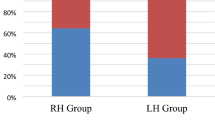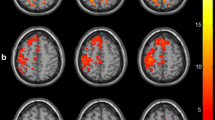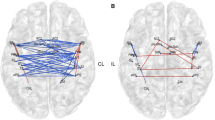Abstract
Sixty-four subacute stroke patients and 55 age-matched healthy controls (HCs) underwent a resting-state functional magnetic resonance imaging scan using an echo-planar imaging sequence and high-resolution sagittal T1-weighted images using a three-dimensional magnetization-prepared rapid gradient echo sequence. Static and dynamic voxel-mirrored homotopic connectivity (VMHC) was computed, respectively. The relationships between the clinical measures, including National Institutes of Health Stroke Scale (NIHSS), illness duration, Fugl-Meyer assessment for upper and lower extremities (FMA-total) and size of lesion volume, and the static/ dynamic VMHC variability alterations in stroke patients were calculated. The stroke patients showed significantly increased static VMHC in the corpus callosum, middle occipital gyrus and inferior parietal gyrus, and decreased static VMHC in the inferior temporal gyrus and precentral gyrus (PreCG) compared with those of HCs. For dynamic VMHC variability, increased dynamic VMHC variability in the inferior temporal gyrus and PreCG was detected in stroke patients relative to that in HCs. Correlation analysis exhibited that significant negative correlations were shown between the FMA scores and dynamic VMHC variability in PreCG. The present study suggests that combined static and dynamic VMHC could be helpful to evaluate the motor function of stroke patients and understand the intrinsic differences of inter-hemispheric coordination after stroke.




Similar content being viewed by others
References
Allen, E. A., Damaraju, E., Plis, S. M., Erhardt, E. B., Eichele, T., & Calhoun, V. D. (2014). Tracking whole-brain connectivity dynamics in the resting state. Cerebral Cortex, 24(3), 663–676.
Archer, D. B., Misra, G., Patten, C., & Coombes, S. A. (2016). Microstructural properties of premotor pathways predict visuomotor performance in chronic stroke. Human Brain Mapping, 37(6), 2039–2054.
Ashburner, J. (2007). A fast diffeomorphic image registration algorithm. Neuroimage, 38(1), 95–113.
Brown, C. E., Li, P., Boyd, J. D., Delaney, K. R., & Murphy, T. H. (2007). Extensive turnover of dendritic spines and vascular remodeling in cortical tissues recovering from stroke. Journal of Neuroscience, 27(15), 4101–4109.
Burton, H., Dixit, S., Litkowski, P., & Wingert, J. R. (2009). Functional connectivity for somatosensory and motor cortex in spastic diplegia. Somatosensory and Motor Research, 26(4), 90–104.
Calhoun, V. D., Miller, R., Pearlson, G., & Adali, T. (2014). The chronnectome: Time-varying connectivity networks as the next frontier in fMRI data discovery. Neuron, 84(2), 262–274.
Caminiti, R., Ghaziri, H., Galuske, R., Hof, P. R., & Innocenti, G. M. (2009). Evolution amplified processing with temporally dispersed slow neuronal connectivity in primates. Proceedings of the National Academy of Sciences of the United States of America, 106(46), 19551–19556.
Carter, A. R., Patel, K. R., Astafiev, S. V., Snyder, A. Z., Rengachary, J., Strube, M. J., Pope, A., Shimony, J. S., Lang, C. E., Shulman, G. L., & Corbetta, M. (2012). Upstream dysfunction of somatomotor functional connectivity after corticospinal damage in stroke. Neurorehabilitation and Neural Repair, 26(1), 7–19.
Caspers, S., Eickhoff, S. B., Geyer, S., Scheperjans, F., Mohlberg, H., Zilles, K., et al. (2008). The human inferior parietal lobule in stereotaxic space. Brain Structure and Function, 212(6), 481–495.
Chen, J., Sun, D., Shi, Y., Jin, W., Wang, Y., Xi, Q., & Ren, C. (2018a). Alterations of static functional connectivity and dynamic functional connectivity in motor execution regions after stroke. Neuroscience Letters, 686, 112–121.
Chen, J., Sun, D., Shi, Y., Jin, W., Wang, Y., Xi, Q., et al. (2018b). Dynamic alterations in spontaneous neural activity in multiple brain networks in subacute stroke patients: A resting-state fMRI study. Frontier in Neurosciences, 12, 994.
Chumbley, J., Worsley, K., Flandin, G., & Friston, K. (2010). Topological FDR for neuroimaging. Neuroimage, 49(4), 3057–3064.
Deiber, M. P., Honda, M., Ibanez, V., Sadato, N., & Hallett, M. (1999). Mesial motor areas in self-initiated versus externally triggered movements examined with fMRI: Effect of movement type and rate. Journal of Neurophysiology, 81(6), 3065–3077.
Doron, K. W., & Gazzaniga, M. S. (2008). Neuroimaging techniques offer new perspectives on callosal transfer and interhemispheric communication. Cortex, 44(8), 1023–1029.
Garrett, D. D., Kovacevic, N., McIntosh, A. R., & Grady, C. L. (2013). The modulation of BOLD variability between cognitive states varies by age and processing speed. Cerebral Cortex, 23(3), 684–693.
Gonzalez-Castillo, J., Hoy, C. W., Handwerker, D. A., Robinson, M. E., Buchanan, L. C., Saad, Z. S., & Bandettini, P. A. (2015). Tracking ongoing cognition in individuals using brief, whole-brain functional connectivity patterns. Proceedings of the National Academy of Sciences of the United States of America, 112(28), 8762–8767.
Grefkes, C., & Fink, G. R. (2011). Reorganization of cerebral networks after stroke: New insights from neuroimaging with connectivity approaches. Brain, 134(Pt 5), 1264–1276.
Grefkes, C., & Fink, G. R. (2014). Connectivity-based approaches in stroke and recovery of function. Lancet Neurology, 13(2), 206–216.
Grefkes, C., Nowak, D. A., Eickhoff, S. B., Dafotakis, M., Kust, J., Karbe, H., et al. (2008). Cortical connectivity after subcortical stroke assessed with functional magnetic resonance imaging. Annals of Neurology, 63(2), 236–246.
Guo, W., Liu, F., Dai, Y., Jiang, M., Zhang, J., Yu, L., Long, L., Chen, H., Gao, Q., & Xiao, C. (2013a). Decreased interhemispheric resting-state functional connectivity in first-episode, drug-naive major depressive disorder. Progress in Neuro-Psychopharmacology & Biological Psychiatry, 41, 24–29.
Guo, W., Liu, F., Xue, Z., Gao, K., Liu, Z., Xiao, C., Chen, H., & Zhao, J. (2013b). Decreased interhemispheric coordination in treatment-resistant depression: A resting-state fMRI study. PLoS One, 8(8), e71368.
Gupta, R. K., Saksena, S., Hasan, K. M., Agarwal, A., Haris, M., Pandey, C. M., & Narayana, P. A. (2006). Focal Wallerian degeneration of the corpus callosum in large middle cerebral artery stroke: Serial diffusion tensor imaging. Journal of Magnetic Resonance Imaging, 24(3), 549–555.
Hindriks, R., Adhikari, M. H., Murayama, Y., Ganzetti, M., Mantini, D., Logothetis, N. K., et al. (2016). Corrigendum to "can sliding-window correlations reveal dynamic functional connectivity in resting-state fMRI?". Neuroimage, 132, 115.
Hofer, S., & Frahm, J. (2006). Topography of the human corpus callosum revisited--comprehensive fiber tractography using diffusion tensor magnetic resonance imaging. Neuroimage, 32(3), 989–994.
Hutchison, R. M., Womelsdorf, T., Allen, E. A., Bandettini, P. A., Calhoun, V. D., Corbetta, M., Della Penna, S., Duyn, J. H., Glover, G. H., Gonzalez-Castillo, J., Handwerker, D. A., Keilholz, S., Kiviniemi, V., Leopold, D. A., de Pasquale, F., Sporns, O., Walter, M., & Chang, C. (2013). Dynamic functional connectivity: Promise, issues, and interpretations. Neuroimage, 80, 360–378.
Inman, C. S., James, G. A., Hamann, S., Rajendra, J. K., Pagnoni, G., & Butler, A. J. (2012). Altered resting-state effective connectivity of fronto-parietal motor control systems on the primary motor network following stroke. Neuroimage, 59(1), 227–237.
Kelly, C., Zuo, X. N., Gotimer, K., Cox, C. L., Lynch, L., Brock, D., et al. (2011). Reduced interhemispheric resting state functional connectivity in cocaine addiction. Biological Psychiatry, 69(7), 684–692.
Krishnamurthi, R. V., Feigin, V. L., Forouzanfar, M. H., Mensah, G. A., Connor, M., Bennett, D. A., Moran, A. E., Sacco, R. L., Anderson, L. M., Truelsen, T., O'Donnell, M., Venketasubramanian, N., Barker-Collo, S., Lawes, C. M., Wang, W., Shinohara, Y., Witt, E., Ezzati, M., Naghavi, M., Murray, C., Global Burden of Diseases, Injuries, Risk Factors Study 2010 (GBD 2010), & GBD Stroke Experts Group. (2013). Global and regional burden of first-ever ischaemic and haemorrhagic stroke during 1990-2010: Findings from the global burden of disease study 2010. The Lancet Global Health, 1(5), e259–e281.
Langhorne, P., Bernhardt, J., & Kwakkel, G. (2011). Stroke rehabilitation. Lancet, 377, 1693–1702.
Li, J., Yuan, Y., Wang, M., Zhang, J., Zhang, L., Jiang, S., Wang, X., Ding, J., & Zhang, K. (2018). Decreased interhemispheric homotopic connectivity in Parkinson's disease patients with freezing of gait: A resting state fMRI study. Parkinsonism & Related Disorders, 52, 30–36.
Liu, F., Guo, W., Fouche, J. P., Wang, Y., Wang, W., Ding, J., Zeng, L., Qiu, C., Gong, Q., Zhang, W., & Chen, H. (2015). Multivariate classification of social anxiety disorder using whole brain functional connectivity. Brain Structure and Function, 220(1), 101–115.
Liu, F., Wang, Y., Li, M., Wang, W., Li, R., Zhang, Z., Lu, G., & Chen, H. (2017). Dynamic functional network connectivity in idiopathic generalized epilepsy with generalized tonic-clonic seizure. Human Brain Mapping, 38(2), 957–973.
Lu, J., Liu, H., Zhang, M., Wang, D., Cao, Y., Ma, Q., et al. (2011). Focal pontine lesions provide evidence that intrinsic functional connectivity reflects polysynaptic anatomical pathways. Journal of Neuroscience, 31(2–3), 15065–15071.
Middleton, F. A., & Strick, P. L. (2000). Basal ganglia and cerebellar loops: Motor and cognitive circuits. Brain Research. Brain Research Reviews, 31, 236–250.
Moore, E. E., Hohman, T. J., Badami, F. S., Pechman, K. R., Osborn, K. E., Acosta, L., et al. (2018). Neurofilament relates to white matter microstructure in older adults. Neurobiology of Aging, 70, 233–241.
Murphy, K., Birn, R. M., Handwerker, D. A., Jones, T. B., & Bandettini, P. A. (2009). The impact of global signal regression on resting state correlations: Are anti-correlated networks introduced? Neuroimage, 44(3), 893–905.
Park, C. H., Chang, W. H., Ohn, S. H., Kim, S. T., Bang, O. Y., Pascual-Leone, A., & Kim, Y. H. (2011). Longitudinal changes of resting-state functional connectivity during motor recovery after stroke. Stroke, 42(5), 1357–1362.
Polania, R., Paulus, W., & Nitsche, M. A. (2012). Reorganizing the intrinsic functional architecture of the human primary motor cortex during rest with non-invasive cortical stimulation. PLoS One, 7(1), e30971.
Preti, M. G., Bolton, T. A., & Van De Ville, D. (2017). The dynamic functional connectome: State-of-the-art and perspectives. Neuroimage, 160, 41–54.
Price, C. J., & Friston, K. J. (1999). Scanning patients with tasks they can perform. Human Brain Mapping, 8(2–3), 102–108.
Pulvermuller, F., Kherif, F., Hauk, O., Mohr, B., & Nimmo-Smith, I. (2009). Distributed cell assemblies for general lexical and category-specific semantic processing as revealed by fMRI cluster analysis. Human Brain Mapping, 30(12), 3837–3850.
Sakoglu, U., Pearlson, G. D., Kiehl, K. A., Wang, Y. M., Michael, A. M., & Calhoun, V. D. (2010). A method for evaluating dynamic functional network connectivity and task-modulation: Application to schizophrenia. Magma, 23(5–6), 351–366.
Salvador, R., Suckling, J., Coleman, M. R., Pickard, J. D., Menon, D., & Bullmore, E. (2005a). Neurophysiological architecture of functional magnetic resonance images of human brain. Cerebral Cortex, 15(9), 1332–1342.
Salvador, R., Suckling, J., Schwarzbauer, C., & Bullmore, E. (2005b). Undirected graphs of frequency-dependent functional connectivity in whole brain networks. Philosophical Transactions of the Royal Society of London. Series B, Biological Sciences, 360(1457), 937–946.
Sarubbo, S., De Benedictis, A., Merler, S., Mandonnet, E., Barbareschi, M., Dallabona, M., et al. (2016). Structural and functional integration between dorsal and ventral language streams as revealed by blunt dissection and direct electrical stimulation. Human Brain Mapping, 37(11), 3858–3872.
Siegel, J. S., Ramsey, L. E., Snyder, A. Z., Metcalf, N. V., Chacko, R. V., Weinberger, K., Baldassarre, A., Hacker, C. D., Shulman, G. L., & Corbetta, M. (2016). Disruptions of network connectivity predict impairment in multiple behavioral domains after stroke. Proceedings of the National Academy of Sciences of the United States of America, 113(30), E4367–E4376.
Stark, D. E., Margulies, D. S., Shehzad, Z. E., Reiss, P., Kelly, A. M., Uddin, L. Q., Gee, D. G., Roy, A. K., Banich, M. T., Castellanos, F. X., & Milham, M. P. (2008). Regional variation in interhemispheric coordination of intrinsic hemodynamic fluctuations. Journal of Neuroscience, 28(51), 13754–13764.
Stinear, C. M., Barber, P. A., Smale, P. R., Coxon, J. P., Fleming, M. K., & Byblow, W. D. (2007). Functional potential in chronic stroke patients depends on corticospinal tract integrity. Brain, 130, 170–180.
Sun, S. W., Liang, H. F., Trinkaus, K., Cross, A. H., Armstrong, R. C., & Song, S. K. (2006). Noninvasive detection of cuprizone induced axonal damage and demyelination in the mouse corpus callosum. Magnetic Resonance in Medicine, 55(2), 302–308.
Sun, S. W., Liang, H. F., Cross, A. H., & Song, S. K. (2008). Evolving Wallerian degeneration after transient retinal ischemia in mice characterized by diffusion tensor imaging. Neuroimage, 40(1), 1–10.
Tang, C., Zhao, Z., Chen, C., Zheng, X., Sun, F., & Zhang, X., et al. (2016). Decreased Functional Connectivity of Homotopic Brain Regions in Chronic Stroke Patients: A Resting State fMRI Study. PLoS One, 11(4), e152875
Thompson, G. J., Magnuson, M. E., Merritt, M. D., Schwarb, H., Pan, W. J., McKinley, A., Tripp, L. D., Schumacher, E. H., & Keilholz, S. D. (2013). Short-time windows of correlation between large-scale functional brain networks predict vigilance intraindividually and interindividually. Human Brain Mapping, 34(12), 3280–3298.
Urbin, M. A., Hong, X., Lang, C. E., & Carter, A. R. (2014). Resting-state functional connectivity and its association with multiple domains of upper-extremity function in chronic stroke. Neurorehabilitation and Neural Repair, 28(8), 761–769.
Varkuti, B., Guan, C., Pan, Y., Phua, K. S., Ang, K. K., Kuah, C. W., et al. (2013). Resting state changes in functional connectivity correlate with movement recovery for BCI and robot-assisted upper-extremity training after stroke. Neurorehabilitation and Neural Repair, 27(1), 53–62.
Wang, L., Yu, C., Chen, H., Qin, W., He, Y., Fan, F., Zhang, Y., Wang, M., Li, K., Zang, Y., Woodward, T. S., & Zhu, C. (2010). Dynamic functional reorganization of the motor execution network after stroke. Brain, 133(Pt 4), 1224–1238.
Wang, L. E., Tittgemeyer, M., Imperati, D., Diekhoff, S., Ameli, M., Fink, G. R., & Grefkes, C. (2012). Degeneration of corpus callosum and recovery of motor function after stroke: A multimodal magnetic resonance imaging study. Human Brain Mapping, 33(12), 2941–2956.
Wang, Y., Li, Z., Zhao, X., Wang, D., Li, H., Xian, Y., Liu, L., & Wang, Y. (2017). Stroke care quality in China: Substantial improvement, and a huge challenge and opportunity. International Journal of Stroke, 12(3), 229–235.
Wise, S. P., Boussaoud, D., Johnson, P. B., & Caminiti, R. (1997). Premotor and parietal cortex: Corticocortical connectivity and combinatorial computations. Annual Review of Neuroscience, 20, 25–42.
Wu, J., Quinlan, E. B., Dodakian, L., McKenzie, A., Kathuria, N., Zhou, R. J., Augsburger, R., See, J., le, V. H., Srinivasan, R., & Cramer, S. C. (2015). Connectivity measures are robust biomarkers of cortical function and plasticity after stroke. Brain, 138(Pt 8), 2359–2369.
Yan, C. G., & Zhao, Y. F. (2010). DPARSF: A MATLAB toolbox for "pipeline" data analysis of resting-state fMRI. Frontiers in Systems Neuroscience, 4, 13.
Yan, C. G., Zhao, Y. F., Colcombe, S. J., Zuo, X. N., & Milham, M. P. (2017). Concordance among indices of intrinsic brain function: Insights from inter-individual variation and temporal dynamics. Scientific Bulletin, 23, 1572–1584.
Yang, G., Wang, Y., Zeng, Y., Gao, G. F., Liang, X., Zhou, M., Wan, X., Yu, S., Jiang, Y., Naghavi, M., Vos, T., Wang, H., Lopez, A. D., & Murray, C. J. (2013). Rapid health transition in China, 1990-2010: Findings from the global burden of disease study 2010. Lancet, 381(9882), 1987–2015.
Yip, E., Yun, J., Wachowicz, K., Gabos, Z., Rathee, S., & Fallone, B. G. (2017). Sliding window prior data assisted compressed sensing for MRI tracking of lung tumors. Medical Physics, 44(1), 84–98.
Yuan, K., Qin, W., Liu, P., Zhao, L., Yu, D., Zhao, L., Dong, M., Liu, J., Yang, X., von Deneen, K., Liang, F., & Tian, J. (2012). Reduced fractional anisotropy of corpus callosum modulates inter-hemispheric resting state functional connectivity in migraine patients without aura. PLoS One, 7(9), e45476.
Zuo, X. N., Kelly, C., Di Martino, A., Mennes, M., Margulies, D. S., Bangaru, S., et al. (2010). Growing together and growing apart: Regional and sex differences in the lifespan developmental trajectories of functional homotopy. Journal of Neuroscience, 30(45), 15034–15043.
Acknowledgements
The authors thank all volunteers who participated in the study and the staff of the Med-X Research Institute and School of Biomedical Engineering Shanghai Jiaotong University in Shanghai, China for their selfless and valuable assistance.
Funding
The study was funded by the National Natural Science Foundation of China (81571277), the National Natural Science Foundation of China (81301200), the scientific research project of the Shanghai health and family planning committee (201740207), and the academic leader training plan of Shanghai Pudong New Area health system (PWRd2016–07).
Author information
Authors and Affiliations
Contributions
JC contributed to the experiments, data analysis and writing of the manuscript. DS contributed to performing the experiments and writing and revising the manuscript. YS contributed to the data collection. WJ designed the experiment and revised the manuscript. YB contributed to the data analysis and manuscript revision. QX and CR are the guarantors of this study and had complete access to all data in the study. All authors are accountable for the contents of this research.
Corresponding authors
Ethics declarations
Conflict of interest
All authors declare that they have no conflict of interest.
Ethical approval
All procedures performed in studies involving human participants were in accordance with the ethical standards of the institutional research committee and with the 1964 Helsinki declaration and its later amendments or comparable ethical standards. Informed consent was obtained from all individual participants included in the study.
Additional information
Publisher’s note
Springer Nature remains neutral with regard to jurisdictional claims in published maps and institutional affiliations.
Rights and permissions
About this article
Cite this article
Chen, J., Sun, D., Shi, Y. et al. Altered static and dynamic voxel-mirrored homotopic connectivity in subacute stroke patients: a resting-state fMRI study. Brain Imaging and Behavior 15, 389–400 (2021). https://doi.org/10.1007/s11682-020-00266-x
Published:
Issue Date:
DOI: https://doi.org/10.1007/s11682-020-00266-x




